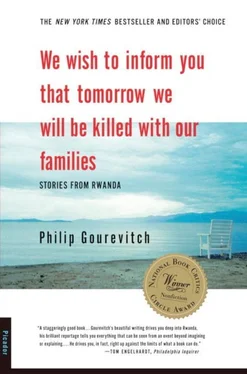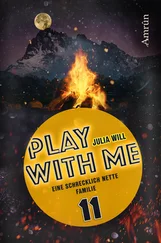By early 1995, a quarter of a million IDPs remained in the camps, of which Kibeho was the largest and home to the largest collection of hard-core génocidaires. The UN and relief agencies, fearing the consequences of coercive closings, offered to come up with an alternative course of action. The government waited. Months went by; but the humanitarians could not agree on a coherent closing plan. In late March, the government announced that time was running out, and in mid-April the RPA was redeployed to do the job: camp by camp, the army sent at least two hundred thousand Hutus home in an orderly fashion.
Kibeho was left for last. Before dawn on April 18, the RPA ringed the camp, which still held at least eighty thousand men, women, and children. Alarmed by the soldiers, and worked into a panic by the resident Hutu Power operatives, the IDPs rushed pell-mell up the hill and gathered in a tight knot around the heavily sandbagged and razor wire-fortified headquarters of Zambatt—UNAMIR’s Zambian contingent. In this stampede, at least eleven children were crushed to death, and hundreds of people were severely burned by overturned cooking pots or badly cut up as they were forced against the UN razor wire.
The RPA tightened its cordon around the throng, and over the next two days, several gates were established around the perimeter. Relief agencies set up registration tables, and about five thousand people from the camp were searched and transported to their homes. But the gates were too few, the registration process was slow, there weren’t enough trucks to speed it up, the génocidaires among the IDPs were putting pressure on the rest not to cooperate, and some foreign relief workers were also advising camp residents to resist evacuation. Little food or water remained in the camp. Most people could barely move; they stood in their own urine and feces. On April 19, some IDPs hurled rocks at the RPA, and some reportedly attempted to grab RPA weapons. Soldiers opened fire, killing several dozen people. In the course of the day members of the Australian medical battalion of UNAMIR, Ausmed, began arriving at the camp to reinforce the Zambians.
Toward evening on April 20, a hard rain began to fall. That night, in the packed camp, some people began hacking at those around them with machetes. There was also sporadic shooting by RPA soldiers and by armed elements within the camp. By morning, at least twenty-one people had been killed, primarily by gunfire, and many more were wounded, primarily by machetes. Children kept getting trampled to death. The RPA kept tightening its cordon. Throughout the next day, people continued to file through the registration points and to leave the camp, mostly on foot, because the rain had made the roads largely impassable. The RPA restricted IDPs’ access to medical and water supplies and periodically fired into the air to drive the crowd toward the registration points. Acts of violence continued within the camp. “At the Zambian company,” an Ausmed officer later recalled, “a group kept running for shelter and hiding in the compound. We helped the Zambians push them back past the wire.”
Late in the morning of April 22, the wet and tormented mass of IDPs at Kibeho once again surged and stampeded against the RPA lines, breaching the cordon at the downhill end of the camp. A stream of IDPs ran through the opening, heading across the valley to the facing hills. RPA troops opened fire, shooting nonstop and indiscriminately into the crowd, and scores of soldiers set out in pursuit of those who had fled, shooting and lobbing grenades at them. The RPA barrage continued for hours; in addition to machine guns, rocket-propelled grenades and at least one mortar were fired into the camp.
Barred by their mandate from using force except in self-defense, the UNAMIR peacekeepers in the Zambatt compound took up weapons only to fend off invasion by the crush of IDPs. Many later recalled weeping in distress and confusion as death and mutilation surrounded them. In typical testimony, a member of Ausmed described seeing “through a window a man attacking a woman with a machete,” then IDPs “throwing bricks, etc., at us,” then RPA soldiers firing rifles and tossing grenades at IDPs, then an IDP shooting at the peacekeepers, then “four RPA chase a young girl behind the Casualty Collection Point and shoot her eighteen times,” then a “vehicle-mounted machine gun… mowing down a large crowd of IDPs in long bursts,” then “RPA kill two old women… kick them downhill.”
Another Ausmed man recalled watching RPA soldiers murdering women and children, and said, “They seemed to be enjoying it.” And yet another Ausmed testimony described a couple of RPA soldiers firing into the crowd: “They were jumping around laughing and carrying on. It was like they were in a frenzy.” The same man also said, “It was pretty horrific to see at least four RPA stand around one IDP and empty a magazine each into him. Some of the IDPs stopped, so the RPA threw rocks at them to make them run again so they could shoot at them again. These IDPs were unarmed and frightened.”
By four o’clock that afternoon, when Mark Cuthbert-Brown, a British major who was serving as provost marshal of UNAMIR, arrived at Kibeho by helicopter, the shooting had tapered off to a sporadic background popping and small bursts of automatic fire. From the air, Cuthbert-Brown had seen long files of thousands of IDPs being searched and registered at RPA checkpoints and heading down the road, away from Kibeho. The Australians, the Zambians, and relief workers had been able to go out and begin collecting the dead and wounded, although their access was often blocked by RPA men. Then, after an hour in the camp, Major Cuthbert-Brown heard “a sudden rise in the tempo of firing.” Once again, the IDPs had broken through the RPA cordon and spilled down the hill, and the eariler scenes of atrocity repeated themselves for several hours. Crouched behind sandbags with binoculars, Cuthbert-Brown watched RPA soldiers hunt the IDPs down the valley and across the far hills, while other RPA soldiers continued to process thousands of IDPs for departure.
Shortly after nightfall, the second wave of intensive shooting abated. Cuthbert-Brown took notes:
20:10 HRS. Become aware of a background wailing from the area of the compound to the west (but this may have built up gradually over a period of time).
21:00 HRS. Wailing continues but there is a letup in firing and grenade explosions.
21:20 HRS. A few grenade explosions heard near the Zambatt HQ.
21:30 HRS. Sporadic single shots in the same area.
21:33 HRS. Six rounds fired by the camp wall.
21:55 HRS. Hysterical screaming rises above the background wailing; Zambian officers speculate that it is related to a machete fight in the compound. Shortly gives way to normal level of wailing; it remains throughout the night.
An Ausmed man said, “We finished up that day disgusted with the RPA and why the UN didn’t send more people in than just a company of Zambians and approximately twenty-five Australians.”
In the night the RPA stopped shooting. “Soon after first light,” Major Cuthbert-Brown wrote in his log, “look over wall… and see bodies strewn around the area.” In the course of the day, tens of thousands of IDPs were marched and trucked out of the devastated camp, as UN teams and relief workers tended to the wounded and counted the dead. By early afternoon, reporters arrived in the camp and Cuthbert-Brown wrote “Media jamboree settles around the graves.” The first death toll to hit the wires was eight thousand, but that was quickly revised down to between two and four thousand—the largest number of them crushed to death in the stampedes, many killed by the RPA, and quite a few hacked, bludgeoned, and even speared to death by interahamwe in their midst. But the numbers were only estimates; the thickness of bodies on the ground in some places made it impossible to navigate the camp, and the RPA obstructed full access.
Читать дальше











